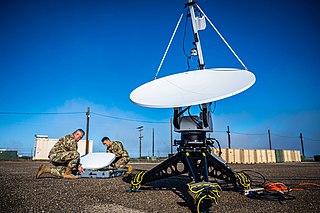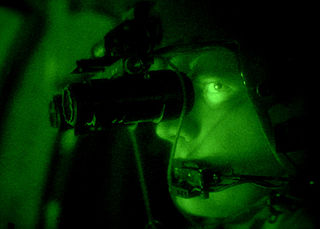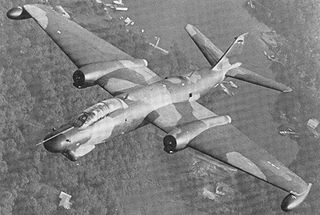
A searchlight is an apparatus that combines an extremely bright source with a mirrored parabolic reflector to project a powerful beam of light of approximately parallel rays in a particular direction. It is usually constructed so that it can be swiveled about.

Electromagnetic warfare or electronic warfare (EW) is warfare involving the use of the electromagnetic spectrum or directed energy to control the spectrum, attack an enemy, or impede enemy operations. The purpose of electromagnetic warfare is to deny the opponent the advantage of—and ensure friendly unimpeded access to—the EM spectrum. Electromagnetic warfare can be applied from air, sea, land, or space by crewed and uncrewed systems, and can target communication, radar, or other military and civilian assets.

Night vision is the ability to see in low-light conditions, either naturally with scotopic vision or through a night-vision device. Night vision requires both sufficient spectral range and sufficient intensity range. Humans have poor night vision compared to many animals such as cats, dogs, foxes and rabbits, in part because the human eye lacks a tapetum lucidum, tissue behind the retina that reflects light back through the retina thus increasing the light available to the photoreceptors.
Semi-automatic command to line of sight (SACLOS) is a method of missile command guidance. In SACLOS, the operator must continually point a sighting device at the target while the missile is in flight. Electronics in the sighting device and/or the missile then guide it to the target.

A night-vision device (NVD), also known as a night optical/observation device (NOD) or night-vision goggle (NVG), is an optoelectronic device that allows visualization of images in low levels of light, improving the user's night vision. The device enhances ambient visible light and converts near-infrared light into visible light which can be seen by the user; this is known as I2 (image intensification). By comparison, viewing of infrared thermal radiation is referred to as thermal imaging and operates in a different section of the infrared spectrum. A night vision device usually consists of an image intensifier tube, a protective housing, and may have some type of mounting system. Many NVDs also include a protective sacrificial lens, mounted over the front lens (ie. objective lens) on NVDs to protect the latter from damage by environmental hazards, and some can incorporate telescopic lenses. The image produced by an NVD is typically monochrome green, as green was considered to be the easiest color to look at for prolonged periods in the dark. Night vision devices may be passive, relying solely on ambient light, or may be active, using an IR (infrared) illuminator to visualize the environment better.

LANTIRN is a combined navigation and targeting pod system for use on the United States Air Force fighter aircraft—the F-15E Strike Eagle and F-16 Fighting Falcon manufactured by Martin Marietta. LANTIRN significantly increases the combat effectiveness of these aircraft, allowing them to fly at low altitudes, at night and under-the-weather to attack ground targets with a variety of precision-guided weapons.

A laser designator is a laser light source which is used to designate a target. Laser designators provide targeting for laser-guided bombs, missiles, or precision artillery munitions, such as the Paveway series of bombs, AGM-114 Hellfire, or the M712 Copperhead round, respectively.

The Leigh Light (L/L) was a British World War II era anti-submarine device used in the Battle of the Atlantic. It was a powerful carbon arc searchlight of 24 inches (610 mm) diameter fitted to a number of the British Royal Air Force's Coastal Command patrol bombers to help them spot surfaced German U-boats at night.

An electronic countermeasure (ECM) is an electrical or electronic device designed to trick or deceive radar, sonar, or other detection systems, like infrared (IR) or lasers. It may be used both offensively and defensively to deny targeting information to an enemy. The system may make many separate targets appear to the enemy, or make the real target appear to disappear or move about randomly. It is used effectively to protect aircraft from guided missiles. Most air forces use ECM to protect their aircraft from attack. It has also been deployed by military ships and recently on some advanced tanks to fool laser/IR guided missiles. It is frequently coupled with stealth advances so that the ECM systems have an easier job. Offensive ECM often takes the form of jamming. Self-protecting (defensive) ECM includes using blip enhancement and jamming of missile terminal homers.

Infrared homing is a passive weapon guidance system which uses the infrared (IR) light emission from a target to track and follow it seamlessly. Missiles which use infrared seeking are often referred to as "heat-seekers" since infrared is radiated strongly by hot bodies. Many objects such as people, vehicle engines and aircraft generate and emit heat and so are especially visible in the infrared wavelengths of light compared to objects in the background.

A light beam or beam of light is a directional projection of light energy radiating from a light source. Sunlight forms a light beam when filtered through media such as clouds, foliage, or windows. To artificially produce a light beam, a lamp and a parabolic reflector is used in many lighting devices such as spotlights, car headlights, PAR Cans, and LED housings. Light from certain types of laser has the smallest possible beam divergence.

A guided bomb is a precision-guided munition designed to achieve a smaller circular error probable (CEP).

The United States Armed Forces has created a plethora of different types of 40 mm grenades in both the low-velocity 40×46 mm and high-velocity 40×53 mm calibers which uses what it calls a high-low propulsion system which keeps recoil forces within the boundaries of an infantry weapon. Presented on this page is a basic overview.

An infrared countermeasure (IRCM) is a device designed to protect aircraft from infrared homing missiles by confusing the missiles' infrared guidance system so that they miss their target. Heat-seeking missiles were responsible for about 80% of air losses in Operation Desert Storm. The most common method of infrared countermeasure is deploying flares, as the heat produced by the flares creates hundreds of targets for the missile.

Operation Shed Light was a crash development project in aerial warfare, initiated in 1966 by the United States Air Force to increase the ability to accurately strike at night or in adverse weather. During the 1960s the United States military worked hard to interdict the movement of men and materiel along the Ho Chi Minh trail. The North Vietnamese were experts in the use of weather and darkness to conceal their movement, and understanding the superiority of American air power put their skills immediately to good use. US forces seeking to impede the steady flow of supplies attempted to locate largely static targets during the day with poor results.
Electro-optical MASINT is a subdiscipline of Measurement and Signature Intelligence, (MASINT) and refers to intelligence gathering activities which bring together disparate elements that do not fit within the definitions of Signals Intelligence (SIGINT), Imagery Intelligence (IMINT), or Human Intelligence (HUMINT).

A precision-guided munition is a guided munition intended to precisely hit a specific target, to minimize collateral damage and increase lethality against intended targets. During the First Gulf War guided munitions accounted for only 9% of weapons fired, but accounted for 75% of all successful hits. Despite guided weapons generally being used on more difficult targets, they were still 35 times more likely to destroy their targets per weapon dropped.

Aircraft camouflage is the use of camouflage on military aircraft to make them more difficult to see, whether on the ground or in the air. Given the possible backgrounds and lighting conditions, no single scheme works in every situation. A common approach has been a form of countershading, the aircraft being painted in a disruptive pattern of ground colours such as green and brown above, sky colours below. For faster and higher-flying aircraft, sky colours have sometimes been used all over, while helicopters and fixed-wing aircraft used close to the ground are often painted entirely in ground camouflage. Aircraft flying by night have often been painted black, but this actually made them appear darker than the night sky, leading to paler night camouflage schemes. There are trade-offs between camouflage and aircraft recognition markings, and between camouflage and weight. Accordingly, visible light camouflage has been dispensed with when air superiority was not threatened or when no significant aerial opposition was anticipated.

The Moonlight Batteries were Searchlight units of Britain's Royal Artillery that specialised in providing 'artificial moonlight', otherwise known as 'movement light' or 'Monty's moonlight', for ground operations during the latter stages of World War II.





















